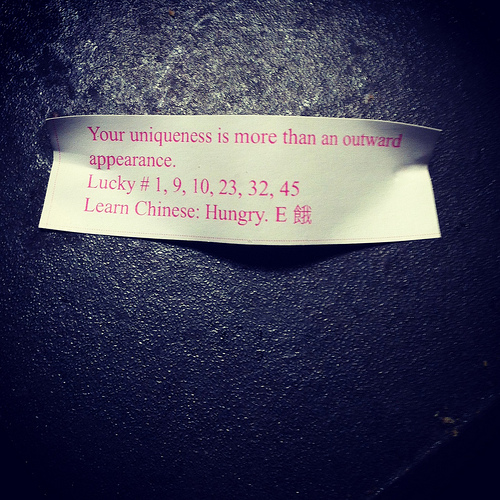
FITTING IN: THE MFA EDITION
[flickr id=”10857294886″ thumbnail=”medium” overlay=”true” size=”medium” group=”” align=”none”]
“A what?”
“A poet.”
As if having my entire extended family think I just walk around in a beret and snapping my fingers isn’t hard enough, leave it to the fate of a fortune cookie to remind me that, yeah, sometimes it’s hard being a poet.
Even once you’ve found the right MFA home and start getting settled into your new environment of peers and poem-making, you begin to formulate ways of negotiating the question that everyone asks: Where have you been published?
During a grad program for creative writing, and even before that, as you’re beginning to think about applying, there’s a lot of pressure to be submitting and publishing in print and online journals. While there are some who don’t care for publishing at all, others practice “submission bombing.” No matter where you fall in the spectrum, publishing is a way of both sharing your work with the poetry community as well trying to start making a name for yourself and your work.
When I first began submitting poems to online journals, I was flummoxed that The New Yorker didn’t want my poem about a fresh open-air Parisian market on Rue Mouffetard. I couldn’t believe that a journal that had just published a poem of James Tate’s didn’t want my poems that, clearly, exhibited the influence of Tate’s early work. I was almost pissed that an editor wrote and said she liked my poems but, unfortunately, at this time, she had to pass. My Submittable and Duotrope accounts began to stack up with nothing but rejections.
[flickr id=”10857294676″ thumbnail=”medium” overlay=”true” size=”original” group=”” align=”none”]
[flickr id=”10857389924″ thumbnail=”medium” overlay=”true” size=”original” group=”” align=”none”]
I would spend hours and hours scouring a journal’s archived issues to find out exactly what kind of poems I should send, and yet I never seemed to manage to figure it out. Not even OkCupid has an algorithm precise enough that could match your poems with an editor’s often mercurial taste. I began to realize that so much more goes into what a journal decides to accept for publication.
[flickr id=”10857294366″ thumbnail=”medium” overlay=”true” size=”medium” group=”” align=”none”]
There are DOs and DON’Ts of submitting all over the internet, but there are a few general guidelines that I think are most important.
1. Know Where to Submit
The best way to know this is to read. You don’t need to be in a basement shuffling through the microfiche of a journal’s history, but you do need to see what they’re currently publishing. But remember: not everything in a particular journal or issue will reflect a single editor’s taste. Take note whether guest editors are a part of the issue’s selection. See what kinds of writing the editors are doing themselves.
What I do is read the journals that are publishing poets that I like. This is also a way to learn about other great poets and to keep abreast of what’s current.
2. Follow Submission Guidelines
This one is easy: FOLLOW SUBMISSION GUIDELINES.
If the guidelines say 3-5 poems, don’t send 7. If they ask for a PDF, don’t send your poems in a Word doc. If they say wait 4 months before sending a query, then do that. If they ask for a short bio, send a short bio. You don’t need to list your entire publication history to get their attention. A lengthy bio isn’t going to make your poems any stronger. And definitely make sure you note whether they accept simultaneous submissions or not.
3. Write a Short, Sweet Cover Letter
You’re not trying to make out with the editors, so you don’t need to be clever or funny. Just be concise and considerate. You might mention something about the journal in particular, but don’t force something that isn’t natural or necessary. Double check the submission guidelines to see if they mention any specifics for the cover letter, i.e., whether to attach it in the same document as the poems, whether to include a bio, etc.
4. Keep Track of Your Submissions
Submittable keeps a clear record of your submissions, but a lot of journals read via email. If you can’t afford the monthly $5 for Duotrope, which also gives you average response times and acceptance/rejection percentages, then find your own system. I keep mine in a document, and I save the submission files with consistent file names (“from_RADIO_Coconut,” “from_RADIO_PANK,” “from_Rincoln_ILK,” etc.).
At the end of the day, remember that you’re asking them to read and publish your work, so be generous with the journal. Having a good relationship with editors goes a long way. If you’ve submitted a piece simultaneously and it gets accepted elsewhere, write them as soon as you can. Don’t expect them to give a lot of feedback or to workshop your poems. If the poems need to be workshopped, then they aren’t ready to be submitted. Remember that Editors are reading a lot of poems and are probably just busy writing poems or going to school themselves.
[flickr id=”10857294646″ thumbnail=”medium” overlay=”true” size=”medium” group=”” align=”none”]
Last fall I submitted a chapbook to a brand new small and independent press that I’d never heard of. All I knew from their Spartan wordpress site was that they were looking for work that was “poignant, well-written, and resonant” and that they were going to hand bind 100 letterpress copies, which was something I was into. So it came as a shock when they chose my work to publish. So don’t be afraid to take chances on new journals or presses that don’t have a longstanding publication history. Sometimes those might be the ones that take a chance on you.
